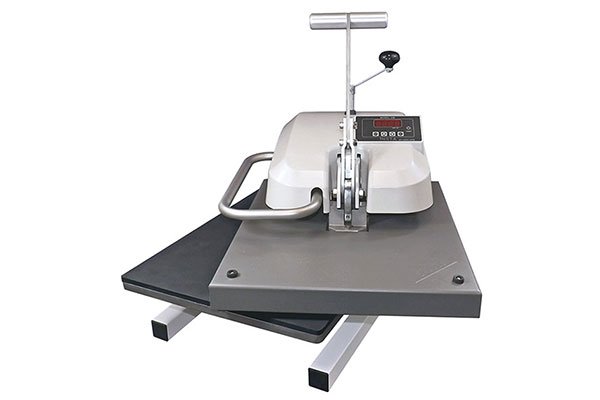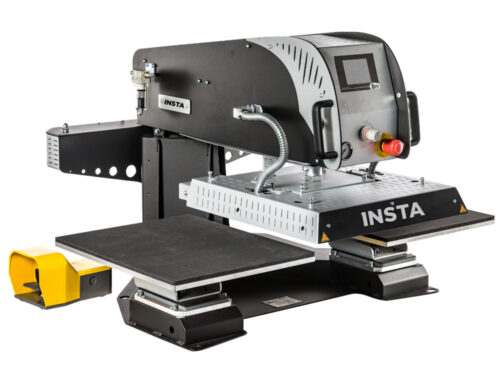
Whether you are new to custom printing or you’ve been at it for years, it’s always exciting to learn a new printing technique that can help step up your game and hone your skills. If you’ve been working with direct to film (DTF) printing and want to try your hand at sublimation printing (or vice versa), this article is for you!
In this blog post, we’ll dive into the world of DTF and sublimation printing, exploring their similarities, differences, pros, and cons of working with these two fascinating techniques. Let’s go!
DTF vs. Sublimation
DTF and sublimation are two popular methods used in the world of decorated apparel and both require heat presses. Both techniques offer unique advantages and can be used to create high-quality designs on various fabrics and garments. Let’s take a closer look at these printing methods and explore their similarities and differences.
Direct to film (DTF) printing involves transferring ink directly onto a specially coated film, which is then backed by a powdered adhesive, cured in a dryer, and finally applied to a substrate using heat and pressure via a heat press machine. This method allows for crisp, detailed prints with vibrant colors. It works well on both light-colored and dark-colored fabrics, making it versatile for creating custom designs on various types of clothing. There isn’t necessarily a specific DTF heat press machine in Insta’s heat press catalog: It’s a process you can use with any of our heat presses! You’ll just need to choose a press based on the size and style substrate you are decorating.
On the other hand, sublimation printing is a process where colored dyes are transferred into the fabric through heat. This can be done by printing transfers on a sublimation printer, then applying those transfers to your substrate with a heat press. The dye molecules become part of the fabric, resulting in long-lasting prints that won’t fade or crack over time. Sublimation works for polyester or polyester blended fabrics, because it requires a high percentage of synthetic fibers to bond with. It also needs to be white fabric to achieve the best results.
DTF Pros and Cons
One of the main advantages of DTF printing is its versatility. It can be used on various types of fabrics, including cotton, polyester, and blends. This means you have more options when it comes to choosing the base material for your designs. Additionally, DTF prints tend to have vibrant colors and excellent color fastness.
On the downside, DTF prints may not be as durable as some other methods like sublimation, screen printing, or screen printed transfers. Over time, frequent washing and wear can cause cracking or fading in certain areas of the design. DTF printers are also currently more expensive than sublimation printers. Finally, operating a DTF system can be more complicated since there are adhesive powders to apply to the transfers after printing and a curing process in a dryer.

Sublimation Pros and Cons
Sublimation printing excels at producing photo-realistic images with smooth gradients and sharp details. One major advantage of sublimation printing is the ability to achieve full-color, photo-quality prints. The dye sublimation process allows the ink to penetrate the fabric fibers, resulting in vibrant colors that won’t fade or crack over time. This makes it ideal for creating detailed designs or reproducing intricate artwork. The prints are also soft to the touch, as the ink becomes part of the fabric rather than sitting on top like with other decoration methods.
However, sublimation printing is limited by its compatibility with synthetic materials only; natural fibers like cotton do not work with this technique as they lack the necessary polymers required for dye-sublimation transfer. It is also limited in that it can only be used with white or at least very light colored fabrics.
Which Process is Best? It’s Up to You!
When it comes to choosing the right printing method for your fabrics and garments, it’s important to consider the specific characteristics of each technique. Direct to film (DTF) printing and sublimation printing have their own strengths and are better suited for different types of materials. When choosing between these two methods, consider factors such as your budget, desired design complexity, fabric type, and order quantity. Direct to film/DTF transfers could be great for smaller runs or when you require a high level of detail in your design. Sublimation printing excels when working with larger quantities or when you need all-over prints on polyester-based materials.
Remember that each technique has its own pros and cons; therefore understanding your goals will help you make an informed decision about which method is best suited for your project.
Understanding which type of fabric or garment works best with each printing method allows you to make informed decisions based on desired outcomes such as color vibrancy, durability, breathability requirements, and more. By considering factors such as budget constraints, design complexity preferences, and fabric types, you can choose the method that will bring out the best in your customized apparel creations.
